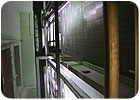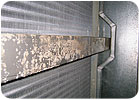
A prime area for the building up of inorganic deposits is on stainless steel sufaces.
Coils in air handlers provide an ideal environment for mold because they are dark, damp, and filled with the nutrients mold thrives on. Once mold establishes itself in a coil or drip pan, it provides an ideal place for bacteria to grow. It also creates other toxins of its own. All of these enter the airstream and threaten the health of building occupants.
According to the World Health Organization (WHO), more than 60 percent of IAQ problems and allergies may be related to mold contamination. Prominent IAQ diagnosticians put the percentage as high as 80 percent.
In addition to health risks, mold also greatly reduces heat exchange, requiring frequent maintenance.
SOLUTIONS
Because mold and its attendant contaminants have been a problem for coils since the beginning of the industry, there have been different approaches used to combat it. One of these approaches involves use of UV technology.While UV has been around for more than 70 years as a means of reducing airborne bacteria, it is only in recent years that its effectiveness in controlling mold on flat surfaces has been achieved, according to those promoting the technology.
Not all UV is the same. UV light is part of the light spectrum that includes radio waves, infrared, visible light, X-rays, gamma rays, and cosmic rays. Ultraviolet (literally beyond violet) is a form of radiation that is invisible to the naked eye. It has shorter wavelengths than can be seen, and it comes in four natural types within the UV section of the light spectrum.
The type of UV light that primarily concerns the HVAC community is called UVC. This type of light has been shown to destroy the DNA of microbial contaminants, including mold, making them sterile. When the existing mold dies, it flakes off of a coil’s surface, leaving it clean.
One of the complaints against UVC is that it only kills what it can “see,” meaning that it cannot penetrate a coil beyond the surface. But those favoring the technology say otherwise. True, the first mold to be killed will be on the outside layer of the coil. But as mold flakes off, it leaves a shiny surface that reflects light, directing the UVC further into the interior of the coil. With the complexity of today’s coil surfaces, UVC light is soon reflected to virtually all of a coil’s surface area. In this manner it not only kills the mold, but also keeps it from coming back.

Drain pan before the use of coil treatment.
UVC IN A MALL
One place the UVC approach was tried was at the Woodland Hills Mall in Tulsa, Okla., where there were problems with air conditioning units.“The rooftop air-handling units were 20 to 26 years old,” said John O. Saville, operations manager for the mall. “When we set out to replace them, our goals were to save energy, simplify maintenance, and deliver the best possible temperature, humidity, and air quality control to our tenants and shoppers.”
One of the methods used with the new rooftops was the installation of UVC lighting for the coils and drip pans. The lights were installed downstream from the cooling coils so they could cleanse the coils and drip pans of mold while killing airborne microbes.
“With the old air handlers, our crews had to clean the evaporator coils annually and the condenser coils twice a year,” said Saville. “We expect the UVC lights to significantly reduce or even eliminate these tasks, and significantly minimize the maintenance staff’s exposure to a variety of chemicals.
“Also, it’s common knowledge that dirty coils experience an increase in pressure drop, which relates directly to higher energy consumption. So even though we specified UVC initially for its IAQ function, we expect it to deliver energy-saving and maintenance benefits as well.”
SOLUTIONS IN PUERTO RICO
Another application was in Sears Las Americas in San Juan, Puerto Rico. The heat and humidity combined to provide an ideal breeding ground; throw in the salty air and you add corrosion to the formula. Carlos Maldonado, facilities manager for Sears/K-Mart Holdings in Puerto Rico, is responsible for the maintenance of more than 90 stores.“We have six 6,000-cfm air-handling units for the San Juan building and we were cleaning the coils three and four times a year and still losing ground,” he said. “It was summer and the temperature in accounting was 85°F.” The coils were covered in an orange jelly-like mold. The one that served accounting was completely clogged.
“I had heard about a UVC company called UVDI from a fellow I knew at York,” said Wilfredo Rivera, president of PMT of Puerto Rico, the mechanical contracting firm that maintained the units. “I suggested to Carlos that we give it a try.”
Maldonado called UVDI and made contact with Bruce Fontaine, the regional sales manager. Fontaine flew in from Florida to assess the situation.
“The coils were six rows deep and the mold was truly a mess. It must have looked to them like they would have to replace the coils,” he said. “I met with Carlos and with Hector Martinez, York’s supervisor technician for Sears. Naturally they were a little skeptical, so I asked them to give me a chance with the worst one of the rooftops. They agreed and we installed our Altru-V products on that unit and checked it weekly.”
“The first week there was no difference,” said Martinez. “The second week there was a little improvement. After the third week the mold was gone - all of it. I asked them why they had replaced the coil in the middle of our test and they said they hadn’t. It was the same coil and it was completely clean, all six rows.”
Maldonado said he plans to install UVC lights on the other five rooftop units.
Publication date:06/04/2007

Report Abusive Comment